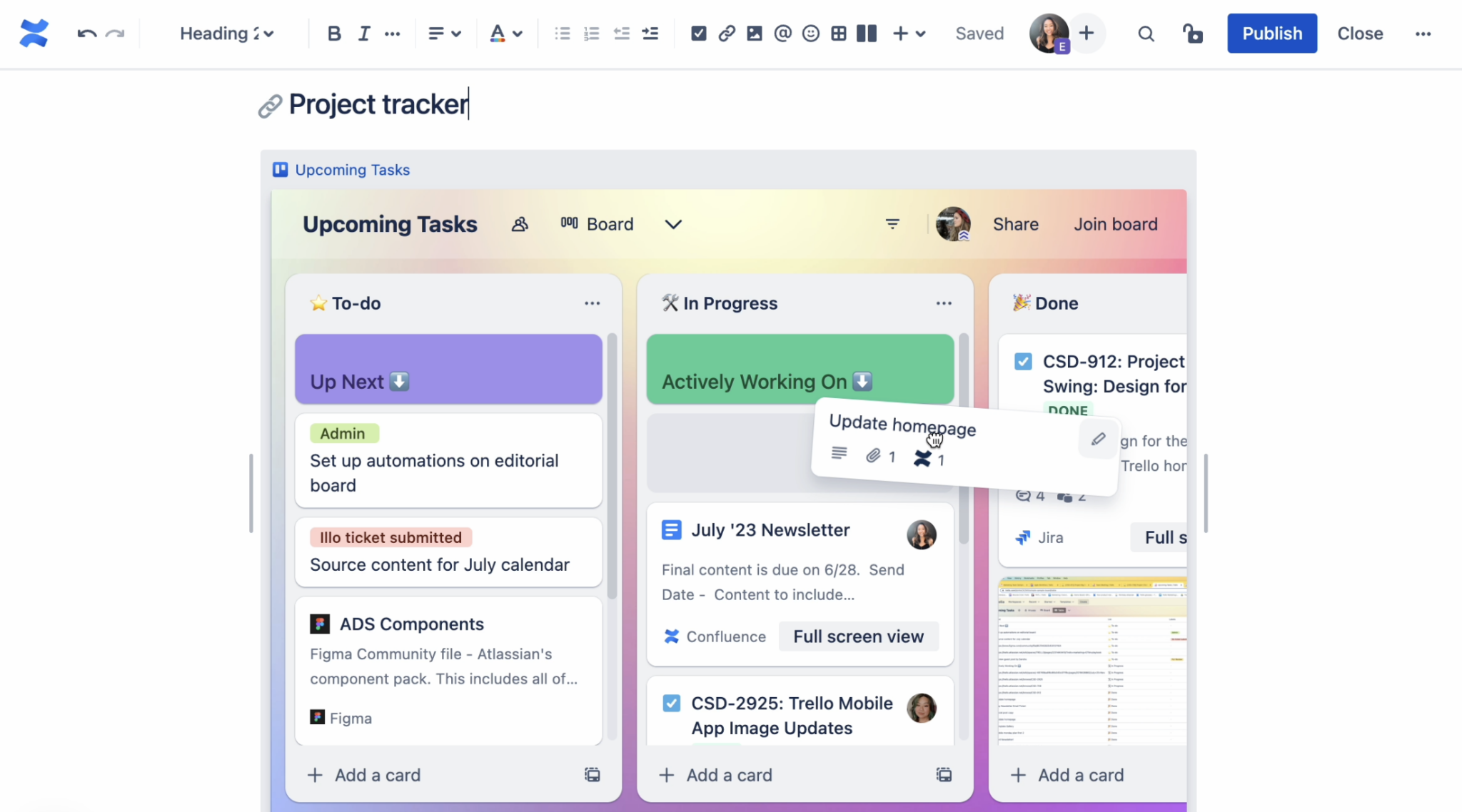Cheese is delicious. Tomato sauce is delicious. Bread is delicious. They’re all so delicious, in fact, they work perfectly well as foods on their own. Yet one day, some brilliant person came along and decided that these delicious foods could become something more: a finer food known as pizza. Our world is all the richer for it.
A similar phenomenon happens in project management. Trello is working well; you’re a regular steam locomotive of productivity and task management. Confluence is working well; your remote team is collaborating and building team knowledge with ease.
If things are really running this smoothly, you might wonder; if it ain’t broke, why fix it?
Because while bread may be good on its own, you want the team collaboration impact of a delicious pizza. And because there are only so many hours in the day, the smoother your team operates, the better they’ll collaborate, communicate, and perform.
Why Combining Trello and Confluence Will Make You More Productive
To explain why we should combine bread and cheese—err, Trello and Confluence—let’s look at a famous case study from the Harvard Business Review. Tom Cochran, Chief Technology Officer at Atlantic Media, noticed he was becoming overwhelmed with emails. He even measured it: 511 incoming emails and 284 sent in one week. Even at just half a minute on average, the sheer tonnage of emails added up to an hour and a half out of his workday, every workday.
Cochran next turned his attention to the entire company. He added up the numbers: salary, average emails spent, time spent on each email per year. His conclusion? All of that invisible email time…
“had soft costs equivalent to procuring a small company [private jet].” -Tom Cochran, as quoted in Deep Work by Cal Newport
In other words, the little things add up in a hurry. Even if you don’t see them.
Similar friction will rear its ugly head with your work management apps: context switching.
Every time you switch over to Confluence (or any other work tool) to check something that wasn’t in Trello, or vice versa, adds a moment of friction to your day.
Alleviating this constant jumping from app to app is one of those secret productivity boons: in this case, integration gives you the best of Trello and Confluence without the context switching. Plus, as you dive into it, you’ll find there are other benefits to this marriage. Consider:
- Trello & Confluence used together make for better planning. You can use Confluence to craft an overarching vision, and Trello to organize that vision into bite-sized tasks. Productivity guru James Clear advocates creating systems to achieve your goals: for example, “running a marathon” is vague, while “run three miles today” is actionable. You need both vision and concrete steps to get where you’re going. The Confluence/Trello combo lets you turn any vision into an actionable system.
- Quicker collaboration. If a team member updates Confluence, why not skip the copying and pasting and have it ring over to Trello? If you’re a flesh-and-blood human being like the rest of us, making yourself do something twice is a recipe for getting behind your collaboration.
- Bringing more work into one view. Access, edit, and collaborate with Confluence directly in Trello, and vice versa. With Trello and Confluence seamlessly integrated, you can say goodbye to tab switching and distractions.!
Classic Trello And Confluence: From Bird’s-Eye View To Finished
We regularly use Confluence to create our vision and strategy for a project, then use Trello to smooth out the nitty-gritty details.
Imagine a pyramid with Confluence on the top—the “eye” of the pyramid, overseeing the big, team-sized pieces of your project. On the bottom half, the “wider” portion of the pyramid is made up of Trello cards. Each Trello card can include information from assignments to links to deadlines, housing all of a project’s nitty-gritty details in one place.
For example, on Confluence, you can create a page that details the project plan — a high-level summary of project details, plan, goals, timelines, and dependencies. Not only does documenting this help align the team on the project priorities, it also acts as a source of truth and a reference document that new project members can easily access to get caught up quickly.
With your project plan ready and team aligned, you can now start to break down your plan into individual, actionable steps within Trello. Create a board that fits your project needs, invite your team, create cards to capture specific tasks (smartlinks make integrating Confluence pages a breeze), and you’re off to the races. You now have every part of your project pyramid complete to make project management a breeze.
How To Sync Trello And Confluence Together
The basic concept is simple: copy your Confluence page link and drop it into a Trello card, or copy your Trello board link and drop it into Confluence.
That’s it! No unnecessary set-ups, no complex integrations.
Linking Confluence within Trello
Once you copy your Confluence page link, there are a number of ways you can use smartlinks to integrate your Confluence pages into your Trello board.
The first is to drop the link directly into a card. This *automagically* creates a Confluence smartcard that allows you to open, edit, and comment right from Trello.

The second is to drop your Confluence page link onto the card back of a Trello card. You can drop the link into the description field or in the comments to add in extra context onto your Trello cards.

You’ll also be able to customize how you want your link to be displayed: a simple url, inline, card style, or a full embed.
Linking Trello within Confluence
Linking your Trello boards into Confluence is just as easy. Like before, all you have to do is copy and paste your board or card link to embed them onto your Confluence page. You’ll get all of the same customization abilities on how you want your Trello content to show up.
On card links, you’ll be able to:
- View card and task statuses
- Comment on cards
- Subscribe for email updates on any changes
- Join cards
- View more info in the card just by clicking, which will take you into Trello—where you can edit the card, just like you’re used to doing
And on fully embedded board links, you’ll be able to edit, update, and move cards around just like you would with Trello opened in another window.

Wherever you are in your project — whether you’re just getting started, totally in the weeds, or jumping in mid-way through, Smartlinks in both Trello and Confluence allow you to work seamlessly across both tools so your whole team can stay on track and on the same page.
Tips For Using Trello And Confluence Together
All right, so you’re convinced that using Trello and Confluence isn’t going to throw a wrench into your well-oiled productivity machine. It’s only going to make you more productive.
That still leaves us with a basic question: how can you make sure this is an improvement over your current system? Here are some tips you can keep in mind:
- Play to the strengths of both tools. Confluence is great for creating collaborative content and knowledge sharing, whereas Trello is great for task management. For project management, use Confluence as your knowledge base for the major materials and files that govern your project, while you figure out the specifics in Trello.
- Leverage smartlinks in both tools. Context is everything, and different players and different moments within your project require working in different tools. By having Confluence pages linked in your project board, and your Trello project board linked in key Confluence documents, you’ll ensure that everybody has the information they need at their fingertips at all times.
Questions And Answers About Your New Trello-Confluence Marriage
Won’t it be weird to sync permissions across both?
Nope. When you add Trello cards to a Confluence page, the software will continue to respect the permissions on the original card. Then the permission request process can happen the exact same way it always would have—working through Trello.
What happens if someone makes an update in Trello? Will I see it in Confluence?
Yes. The synchronization will occur across both platforms, meaning that if someone updates a card in Trello and you’re viewing it in Confluence, you’ll see the updated info—in real-time.
What if I like Trello and don’t want to abandon it?
The good news is you don’t have to. You can incorporate Trello cards and even full Trello boards into Confluence and use them together. You’ll have the same access to Trello features—you’re simply changing the way you access them. And everyone on your team will be able to keep using Trello, too.
What if I don’t have a remote team?
Both of these tools are built for all teams to manage their work—no matter where they are. Consider how McCorvey, a metal manufacturing company, used Trello to digitize its old paper processes. They needed an application for handling every aspect of manufacturing—from welding to shipping—and pulled it all together in Trello, minimizing the need for complicated paperwork.
What if I’m not sure how to do something, like add new documentation?
Both Trello and Confluence have extensive help documentation covering all of the details of using each product. Additionally, you can also contact our support team for more help here.
Making Trello And Confluence Work Together
These two project management tools might seem like they overlap, but the truth is, they can work together in perfect synergy. And since there isn’t a complicated onboarding process, you can take existing Trello and Confluence accounts and cinch them together today. Just set the oven to 450, put on those oven mitts, and bake for about twenty minutes.
Oh, wait. That was that other thing.

